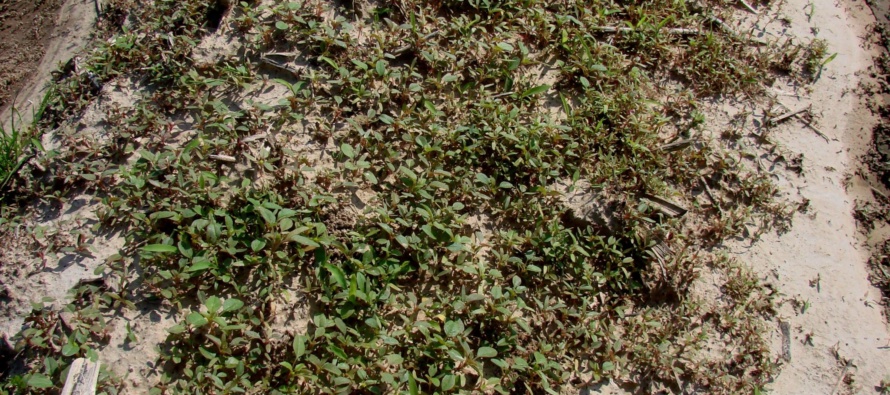Control Palmer Amaranth Early

Related Articles
- 2010 Soybean And Corn Variety Trial Data 3
- Rice Variety Trial Results For 2010, Plus Rice Research Report 0
- Fertilizing Cotton with Poultry Litter 5
Latest Tweets
Key Points to Remember:
- Preplant herbicide treatments targeting Palmer amaranth should include paraquat at 0.75 pounds active ingredient per acre to control emerged plants.
- Preplant applications for Palmer amaranth in soybean should include herbicides representing multiple effective modes of action.
- New auxin herbicide products for use in Enlist and Xtend crops are labeled for preplant applications, but their associated application requirements must be followed.
- Preplant intervals for older 2,4-D and dicamba herbicide products must be observed even in fields to be planted to crops with the Enlist or Xtend traits.
 Because of the warm weather in March, many fields in Mississippi already contain emerged Palmer amaranth. Therefore, in fields that will not be planted for two to four more weeks, a residual herbicide for Palmer amaranth in a burndown application is critical. These treatments should include paraquat (Gramoxone SL, etc.) at 0.75 pounds active ingredient per acre to control any Palmer amaranth that is emerged at application. Options for preplant residual herbicide treatments might include Valor at 2 ounces per acre (requires 30-day preplant interval) or Reflex at 1 pint per acre (requires 0.5 inch rainfall or 10- to 14-day preplant interval) for cotton. Atrazine at 1 quart per acre is a good choice in fields to be planted to grain sorghum.
Because of the warm weather in March, many fields in Mississippi already contain emerged Palmer amaranth. Therefore, in fields that will not be planted for two to four more weeks, a residual herbicide for Palmer amaranth in a burndown application is critical. These treatments should include paraquat (Gramoxone SL, etc.) at 0.75 pounds active ingredient per acre to control any Palmer amaranth that is emerged at application. Options for preplant residual herbicide treatments might include Valor at 2 ounces per acre (requires 30-day preplant interval) or Reflex at 1 pint per acre (requires 0.5 inch rainfall or 10- to 14-day preplant interval) for cotton. Atrazine at 1 quart per acre is a good choice in fields to be planted to grain sorghum.
Several herbicides containing multiple modes of action effective against Palmer amaranth are available for preplant application to soybeans. Authority Elite and Fierce are both premixes of Group 14 (PPO inhibitors) and Group 15 (VLCFA inhibitors) that work well in preplant applications in soybean. Group 14 and 15 herbicides are both effective for residual control of Palmer amaranth. Other herbicide options include Envive, Sharpen, Sonic, Surveil, Valor XLT, or Verdict. These herbicides either contain a single herbicide mode of action or they are premixes of Group 14 and Group 2 (ALS inhbitors) herbicides. Resistance to ALS inhibitors (Group 2) is prevalent in Palmer amaranth in Mississippi, so those products only contain one herbicide mode of action effective against Palmer amaranth. A Group 15 herbicide should be included to provide two effective modes of action.
 Scouting fields between the time of the preplant residual herbicide application and planting will be critical. Scouting will provide information on how well the preplant residual treatment performed, but will also be crucial for determining if Palmer amaranth emerged at application was completely controlled. Paraquat is a great herbicide, but most of us have learned the hard way that 100% control of Palmer amaranth is the exception rather than the rule. Paraquat may not provide complete control when Palmer amaranth exceeds six inches.
Scouting fields between the time of the preplant residual herbicide application and planting will be critical. Scouting will provide information on how well the preplant residual treatment performed, but will also be crucial for determining if Palmer amaranth emerged at application was completely controlled. Paraquat is a great herbicide, but most of us have learned the hard way that 100% control of Palmer amaranth is the exception rather than the rule. Paraquat may not provide complete control when Palmer amaranth exceeds six inches.
Yearly use rates for paraquat vary by crop because it may be used in-season for some crops under certain circumstances. However, paraquat labeling allows three applications prior to crop emergence for cotton, grain sorghum, rice, and soybeans. Use paraquat judiciously to get an in-season weed control program off to a good start.
One last note concerning preplant herbicide applications. Enlist Duo is the only herbicide product that contains 2,4-D labeled for application to crops in the Enlist Weed Control System. Xtendimax with VaporGrip, Engenia, and FeXapan plus VaporGrip are the dicamba herbicide products labeled in Mississippi for application to crops in the Roundup Ready Xtend Crop System. These new products are labeled for preplant applications, but the application requirements specified on the federal label for Enlist Duo and supplemental labels for Xtendimax, Engenia, and FeXapan must be followed. Older formulations of 2,4-D and dicamba are still labeled for burndown applications in Mississippi. However, the preplant intervals for these products must be followed even in fields to be planted to crops with the Enlist or Xtend traits. For example, if Clarity is applied to a field to be planted to Xtend soybean, the field cannot be planted until it receives at least one inch of rainfall and 15 days elapse.




Let me tell You a sad story ! There are no comments yet, but You can be first one to comment this article.
Write a comment